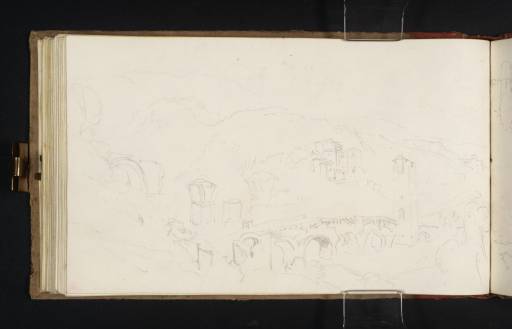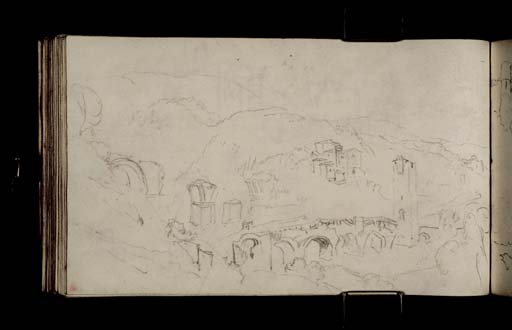Joseph Mallord William Turner Bridge of Augustus and the Medieval Bridge, Narni 1819
Image 1 of 2
Joseph Mallord William Turner,
Bridge of Augustus and the Medieval Bridge, Narni
1819
Joseph Mallord William Turner 1775–1851
Folio 61 Verso:
Bridge of Augustus and the Medieval Bridge, Narni 1819
D14772
Turner Bequest CLXXVII 61 a
Turner Bequest CLXXVII 61 a
Pencil on white wove paper, 110 x 186 mm
Accepted by the nation as part of the Turner Bequest 1856
Exhibition history
2008
Turner e l’Italia/Turner and Italy, Palazzo dei Diamanti, Ferrara, November 2008–February 2009, National Gallery of Scotland, Edinburgh, March–June 2009 (41, reproduced in colour).
2009
Turner és Itália, Szépmuvészeti Múzeum, Budapest, July–October 2009 (no number, reproduced in colour).
References
1909
A.J. Finberg, A Complete Inventory of the Drawings of the Turner Bequest, London 1909, vol.I, p.522, as ‘Narni, with Bridge of Augustus’.
1984
Cecilia Powell, ‘Turner on Classic Ground: His Visits to Central and Southern Italy and Related Paintings and Drawings’, unpublished Ph.D thesis, Courtauld Institute of Art, University of London 1984, pp. 101, 469 note 143, 103 note 154, 356 note 33, reproduced pl.209.
1987
Cecilia Powell, Turner in the South: Rome, Naples, Florence, New Haven and London 1987, pp.34, 35.
2008
James Hamilton, Nicola Moorby, Christopher Baker and others, Turner e l’Italia, exhibition catalogue, Palazzo dei Diamanti, Ferrara 2008, no.41, pp.44, 90 note 29, [143], [179], reproduced in colour, p.182 as ‘Narni con il ponte di Augusto’.
2009
Christopher Baker and James Hamilton, Turner és Itália, exhibition catalogue, Szépmuvészeti Múzeum, Budapest 2009, p.45, reproduced p.43, fig.42.
The town of Narni occupies the crest of a hill approximately seven miles south-west of Terni, and fifty miles north of Rome. As was often the case during Turner’s travels, his mode of travelling did not give him much opportunity to stop and explore. The carriage simply followed a predetermined course in an anti-clockwise direction from east to south-west around the walled perimeter. Consequently Turner’s sketches of Narni relate to views visible from the outskirts of the town; there are no records of subjects within the centre, see folios 63 verso (D14776), folio 69 verso (D14788). He did however, devote a considerable number of drawings to the Bridge of Augustus (Ponte d’Augusto), one of the most famous landmarks in Umbria. An impressive monument to Roman engineering, the bridge which was built in 27 BC originally stood 30 metres high and stretched 160 metres, carrying the ancient Via Flaminia across the ravine of the Nera valley. It collapsed some time during the thirteenth century and the surviving ruins comprise one complete arch and the remains of the other supporting columns.
This sketch depicts the view from the road leading down to the bridge at the northern tip of the town, see folio 61 (D14771). Turner’s viewpoint is consequently from high ground above looking down into the Nera gorge. In the foreground to the right of the Bridge of Augustus is the adjacent medieval bridge and watchtower of Narni, destroyed by Allied bombing during the Second World War. On the opposite side of the ravine is the Santuario della Madonna del Ponte, so-called because of its proximity to the Roman bridge, see folio 49 (D14748).
The Bridge of Augustus was already a familiar sight to Turner, having formed the subject for one of his engraved illustrations for James Hakewill’s Picturesque Tour in Italy, published 1819. The composition of the watercolour, The Bridge at Narni (whereabouts unknown),1 was based upon a design by Hakewill himself, a composition which Turner deliberately or subconsciously echoed in another sketch within this sketchbook, see folios 62 and 63 (D14773 and D14775).2 His excitement at finally seeing the site with his own eyes may be gauged by the large number of sketches he made of it from both down and up-river, see also folios 64–68 (D14777–D14785). Although the bridge never became the principal subject of a finished painting after 1819, John Ruskin identified that the topography on the right-hand side of Childe Harold’s Pilgrimage exhibited 1832 (Tate, N00516),3 was based ‘on faithful reminiscences of the defiles of Narni, and the roots of the Apennines’.4 Furthermore, Cecilia Powell has suggested that the bridge is actually an imaginary composite using features from both the bridges of Narni; the large arches of the Bridge of Augustus, and the tower of the medieval bridge.5 There is also some similarity, however, to the Ponte San Giacomo at Foligno, see folio 33 verso (D14717).
Nicola Moorby
November 2008
Andrew Wilton, The Life and Work of J.M.W. Turner, Fribourg 1979, no.702. Previous owners include Munro of Novar and John Ruskin; W.G. Rawlinson, The Engraved Work of J.M.W. Turner, R.A., vol.I, London 1908, no.146.
Tony Cubberley and Luke Herrmann, Twilight of the Grand Tour: A Catalogue of the drawings by James Hakewill in the British School at Rome Library, Rome 1992, no.2.52, reproduced p.169.
Martin Butlin and Evelyn Joll, The Paintings of J.M.W. Turner, revised ed., New Haven and London 1984, no.342.
How to cite
Nicola Moorby, ‘Bridge of Augustus and the Medieval Bridge, Narni 1819 by Joseph Mallord William Turner’, catalogue entry, November 2008, in David Blayney Brown (ed.), J.M.W. Turner: Sketchbooks, Drawings and Watercolours, Tate Research Publication, December 2012, https://www


